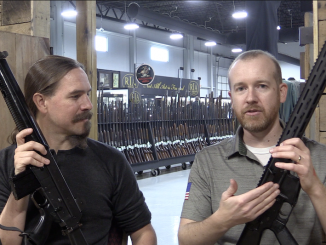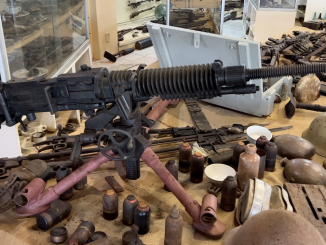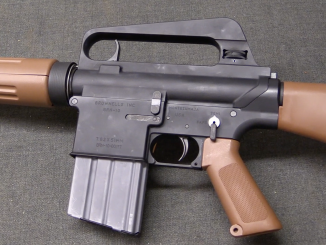Lot 237 in the September 2019 RIA auction.
During the Civil War, the Union purchased about 12,000 Spencer rifles and many tens of thousands of carbines, and the weapon became a standard arm for the Cavalry service. After the war, thousands of Spencers were in warehouses and arsenals in need of refit either from combat damage or just abuse and neglect. Springfield Armory took on the job of repairing these weapons after the war. In February of 1871, the Armory commandant suggested that he had received a batch of about 1,100 Spencer carbines from Fort Leavenworth, and that he could refit them into infantry rifles. This plan was approved by the Ordnance Department, and a total of 1,109 conversions were produced in 1871.
The conversion work was done by replacing the Spencer barrel with a new three-groove 1868 model rifle barrel (32.5 inches long) and 26 inch cleaning rod. Two barrel bands were used instead of the three on factory-original Spencer rifles. The wood and metal were refinished or repaired as necessary, and the receiver serial number (which could be anything from 1 to 34,000) was added to the left side of the barrel. If the carbine did not have a Stabler cutoff, one was added.




I was surprised that these were replaced with the trapdoor Springfield until you and Karl did a comparison. Having to manually cock the hammer for every shot tends to negate the advantage of a repeater over a single shot weapon.
The very slow reloading of tube magazines makes the ‘reserve repeater’ idea more sensible. The speed advantage in firing from the magazine is just about negated by the amount of time it took to recharge. Steady single shots would average out to be not much slower than 7 round mag-dumps followed by agonizingly slow reloads.
The Blakeslee reloading device sped up the Spencer reloading procedure considerably;
http://www.ssfirearms.com/proddetail.asp?prod=L46
Variants held from six to ten tinplate tubes, each holding one complete magazine full of Spencer cartridges.
Similar devices are still made today as speedloaders for tubular magazine repeating shotguns;
http://csus-dspace.calstate.edu/bitstream/handle/10211.3/158469/Kit%20Spelman_Thesis.pdf;sequence=1
The best that could be done for the “Trapdoor” Springfield in this area was the Metcalfe attachment for the Model 1873 Springfield;
https://www.morphyauctions.com/jamesdjulia/item/lot-1489-rare-springfield-model-1873-trapdoor-rifle-with-metcalfe-experimental-cartridge-block-attachment-47740/
Similar devices were used by the Russian army with their single shot Krnka breechloading conversions (an unlicensed copy of the 1862 Joslyn)during the Russo-Turkish War (1870-78). They proved to be largely ineffective vs. Turkish troops armed with the faster-operating Peabody and even faster-firing Winchester Model 1866.
Ironically, not long after these arsenal reconditions of the Spencers was completed, the Spencer was completely withdrawn from service with the Army in favor of the longer-ranged but single-shot Springfield (mid-1873).
At that point, the Army’s theorists were still thinking in terms of ultra-long-range (800 yard plus) fire, rather than very rapid fire at more realistic engagement ranges (300 yards or less) as they had experienced in the Civil War. The superior range of the .45-70 cartridge was, they believed, sufficient to overcome any enemy before they could close to “firefight” range.
This assessment was to be repeatedly proven erroneous, as it already had been several times during the “recent unpleasantness”.
The bill was called due three years later, at the Little Big Horn.
clear ether
eon
According to official Army records, the Ordnance Board preferred the Spencer over the faster-firing Henry precisely because of its separate thumb-cocking system. They believed that the Henry’s automatic cocking as the lever was operated would lead to accidental discharges, plus the usual bugaboo of “wasting ammunition”.
cheers
eon
Before we dismiss the “wasting ammunition” reason as completely stupid, remember that many repeating weapons (with any magazine capacity greater than five rounds) tend to instill a mystical impression of infinite ammunition capacity in lots of inexperienced grunts (not kidding you, give a modern-day moron a Thompson M1921 with a fifty-round drum magazine and he’ll think he’s got enough firepower to turn the entirety of Chicago into Swiss Cheese, especially if he has never seen a magazine change in his life!). In essence, any grunt dumb enough to think his weapon will win a fight for him will abuse the magazine capacity and simply dump more lead downrange without even aligning the sights. “So many bullets! ONE OF THOSE HAS GOT TO HIT HIM!!” Let’s don’t even get into fully-automatic long arms and panicked soldiers dumping full magazines after mistaking local wildlife for enemy soldiers in the dark! Just kidding!
“(…)fully-automatic long arms and panicked soldiers(…)”
But this indicates problems with training not fire-arm itself.
Training has never been any army’s favorite budget item. Generally, it’s what gets cut first in budget cuts. And the U.S. Army’s budget, like its manpower, was drastically downsized after Appomattox.
The single-shot Trapdoor Springfield was a cheap conversion of the Model 1861 Springfield .58 rifle musket to begin with, in .58 rimfire. Later, as entirely new rifles in first .50-70 and then .45-70 centerfire were manufactured, they could be built on modified .58 M1861 machinery, thus economizing on new tooling.
And being single-shots, they required less training time.
The “Trapdoor” Springfield is not a particularly good design, even among single-shot conversions. It is fairly weak, and in event of a case failure or etc. consistently commits the unforgivable sin of a breechblock; the breech lets go before the barrel or chamber fails, giving the operator a face full of hot gas, plus brass and even steel fragment.
By comparison, the Remington Rolling Block inevitably does just the opposite; the barrel and chamber rupture before the breech lets go.
So does the Snider. It and the Springfield were both designed at Springfield at the same time. Jacob Snider was a subordinate of Erskine Allin, the Armory’s director, who “designed” the Trapdoor, known officially as the “Allin conversion”.
Allin actually “borrowed” most of its features from Col. Hiram Berdan’s “Berdan I” breech; years later, Berdan’s widow was paid a rather large indemnity by the U.S. government for patent infringement, after losing a suit in Federal court.
Snider’s breech was a simpler square block rotating on a hinge parallel to the bore line. It was contained in a steel “shoe” screwed to the back end of the barrel.
After being cashiered for “insubordination” by a rump review board instigated by Allin, who didn’t want any competition for “his” breech design, Snider went to England, where the British army found a lot to like about his breech. The result being the .577 Snider-Enfield.
Like the Rolling Block, the Snider breech pretty much never fails in an overpressure event. It’s basically a steel “brick” in a steel “box”; to fail would require steel to be compressed upon steel, and at black-powder pressures that just doesn’t happen in anything smaller than an artillery piece.
The Trapdoor, by comparison, is held shut by a spring latch and the hammer spring as the hammer lands on the firing pin. It works most of the time, but when it fails, it does so spectacularly and dangerously.
I once read a Gun Digest article in which a supposed “expert” sang the praises of the Trapdoor over the Rolling Block and the Snider, precisely because the breech failed before there was a barrel failure. He opined that this was somehow “safer” than the other way around.
I must conclude he’d never seen the results of a genuine breechblock failure- on the operator. I have.
I must also conclude that he didn’t understand gas dynamics, metallurgy, or even much basic physics. Unfortunately, few “gun writers” actually do, so he was hardly unique.
Yes, the Trapdoor was “cheap” when the U.S. Army badly need new rifles, but didn’t have a lot of money to spend on making them, or training troops to use them. Other than that, it had no real virtues and some vices that ranged from annoying to potentially deadly.
Oh, and PS; Hiram Berdan wasn’t satisfied with his own Berdan I “trapdoor” for those exact reasons.
His second design, the Berdan II, was a bolt-action.
cheers
eon
“(…)Snider went to England, where the British army found a lot to like about his breech. The result being the .577 Snider-Enfield.(…)”
Yes, but British used that weapon with crucial improvement: cartridge designed by Colonel Boxer. Also what was great plus, was that Snider system was relatively simple in usage, as back then most British soldiers were coming from lower classes and Of 73,000 men 2,000 have a fair knowledge of the three Rs, 20,000 could neither read nor write, and 13,000 could read but not write.
http://www.hbsa-uk.org/knowledge-and-research/articles/snider-conversion-and-magdala
“(…)By comparison, the Remington Rolling Block inevitably does just the opposite; the barrel and chamber rupture before the breech lets go.(…)”
Well, that is totally fair as Allin was conversion of muzzle-loader, while Rolling Block is not (was designed from beginning as breech-loader).
What about French Tabatière or Russian Krnka?
D;
Before standardizing on the Trapdoor, Springfield built the following conversions of the M1861 and M1863 to metallic-cartridge breech-loading;
1865- Joslyn conversions; 3,005
1866- Remington rolling block conversions- 805
1871- Ward-Burton bolt-action conversions- 1,015
Plus Chaffee-Reece, Springfield-Lee, Morse, and other conversions made in small numbers from 1866 to 1885.
Interestingly, the United States Navy and Marine Corps never standardized the Trapdoor. They used Remington Rolling Blocks in .50-70 and .45-70, first conversions of M1863 Springfields with sleeved .58 barrels, and later new-production rifles that were substantially identical.
So there were certainly “cheap” alternatives to the Trapdoor. But they weren’t developed “in-house” by the Director of Springfield Armory.
A good overview of the Trapdoor and its competitors can be found here;
https://www.forgottenweapons.com/wp-content/uploads/2013/10/U.S.-Army-Rifle-and-Carbine-Adoption-1865-1900.pdf
To put it bluntly, the fix was in on behalf of “Allin”‘s Trapdoor right from the start. The Act of Congress prohibiting serving officers from receiving royalties on weapon designs used by the Army was “aimed” straight at him, and also intended to discourage future imitation of his antics.
As for the Krnka, it was never considered because when it was first unveiled in 1865, it was recognized as an unlicensed knockoff of Joslyn’s 1861 metallic-cartridge breech design, which was patented in the United States. (It succeeded Joslyn’s 1859 design for a linen-cartridge breechloader similar in concept to the British Westley Richards “Monkey Tail”.)
This patent was respected in England and France, but not in Russia, where the Krnka breech was used to convert thousands of .69 muskets to breech-loading. They were used in the Russo-Turkish war of 1870-79, and were considered inferior to most of the other arms used in that conflict.
It’s ironic that two of the more widely-used breechloading conversions were credited to men who stole other designers’ patents.
Rollin White was probably jealous.
cheers
eon
“(…)Remington rolling block conversions(…)”
Huh, I always though it was stand-alone design. But this reminded me one proverb, which fits for Springfield action in 19th century:
hominis est errare, insipientis in errore perseverare
They did not replace Allin conversion with better single-shot design as other nations have done (Great Britain: Martini-Henry, Republic of France: Chassepot, Czardom of Russia: Berdan II and so on)
This is a real long rifle for basement bargain price 🙂
Seriously though, since I was in past interested in Spencer carbine (the fact of storing ammunition in stock is ingenious, not to mention first fast repeating action) I am happy to see this ‘update’. As always – great work, Ian!
“(…)storing ammunition in stock is ingenious(…)”
I would say it is intuitive if you are accustomed to single-shot breech-loaders: after all you are pushing cartridge into chamber, so it seems more natural to place cartridges that they are just pushed, than firstly pulled then pushed. It also allow Spencer carbine to looks more like single-shot fire-arm – aesthetics to which then-current potential users were more accustomed to. For pragmatic user that should make no difference, but I guess many potential users purchasing decisions were actually influenced by look.
Rear-magazined repeating rifle would appear also later in history, examples: Winchester Hotchkiss (used by U.S. Navy in last quarter of 19th century, .45-70 cartridge) and Evans Repeating Rifle (commercial, use own cartridge).
After end of 19th century rear-magazined center-fire rifles had fallen into oblivion, though it was still used in some rim-fire (.22 caliber) rifles namely:
Remington Model 241, see 3rd image from top: https://www.remingtonsociety.org/remington-model-241-autoloading-rifles/
Winchester Model 1903, see 7th image from top: https://www.historicalfirearms.info/post/168059981329/winchester-model-1903-model-63-the-winchester
What’s the story with a 26″ cleaning rod for a 32″ barrel?
A couple of Ahem nit.. cough.. picking.. cough cough items. The Spencer Rifle company had a rather large existing order from the Navy and Army by the time of the Lincoln/ Spencer test firing. All the springfield conversions that I have seen have been built on Burnside contract Carbines. The chambers for the Springfield conversions tend to actually be slightly longer than the old factory barrels allowing for a slightly longer cartridge and loading (as long as the overall length will cycle through the action.
Several points
1) It wasn’t until the 1930’s that a British infantry battalion reported a 100 percent literacy rate. This is important because the records show that the more educated the recruit, the batter soldier he makes and the less disciplinary problems.
2) What I didn’t see addressed is the question of why do the conversion at all? 1000 weapons after the Civil War was a drop in the bucket – there were more than weapons enough to give every man (circa 25,000 if I remember correctly) in the Army his own private armory. I can see refurbishing the carbines as carbines prior to putting them in storage. After all, if they ever need to be pulled from storage, the cavalry will be going through an expansion and – guess what – need carbines. Just because you can do something, doesn’t mean you should it.